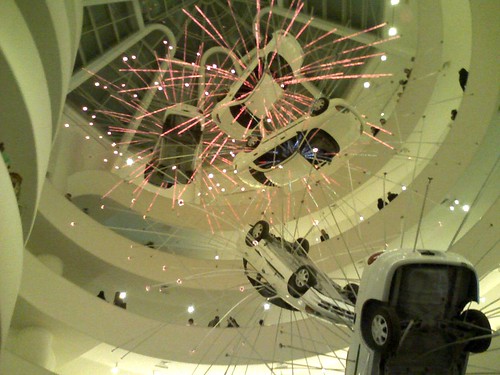Listen!
Harrigan is a docent at the Guggenheim, leading tours — "interactive discussions," which I now realize is redundant, "of current exhibitions" — and I thought it would be fun hearing her talk and a wide open door into art appreciation, so I followed her and about seven other people around the museum's current show, Cai Guo-Qiang: I Want to Believe. Not to be confused with the similarly-subtitled X-Files movie coming out this summer, like nine years too late. The centerpiece of Cai's show is Inopportune: Stage One, seen here lifted off someone's Flickr page. It's a pretty spectacular sight, and I don't have my own photograph because the Guggenheim has a team of security nazis telling tourists "no photography" and just being utter tools in general. I'll have more to say about this later.
The centerpiece of Cai's show is Inopportune: Stage One, seen here lifted off someone's Flickr page. It's a pretty spectacular sight, and I don't have my own photograph because the Guggenheim has a team of security nazis telling tourists "no photography" and just being utter tools in general. I'll have more to say about this later.
It took me a while to get a grip on what's going on here, even though Cai's liner notes (or whatever the art museum equivalent is called) make a point of his trying to make the show straightforward and free from the elitist art references that occlude so many other modernists' meanings. First I saw a bunch of cars hanging from the ceiling with colored light rods sticking out of them. Then the colored light rods sort of fused with my mental images of fireworks, which is closer thematically, yet still utterly wrong as an abstraction of the artist's experience and intent.
I've never been good at this art appreciation thing. I sat through my Art Humanities class in college convinced it was one giant trick question: everything was pulled from somebody's ass, on either extreme of obvious or obscure and never just fitting together neatly. We might be looking at a slide of Raphael's Madonna of the Goldfinch and the professor will point out that the figures of Mary, Jesus, and John the Baptist form a triangle, and a triangle has three sides, and there are three manifestations of God in the Holy Trinity so (duh!) this painting of Mary, two creepy naked babies, and a bird represents the Holy Trinity, and the class will be gaping like she just solved the Da Vinci Code. Connecting any three points with straight lines will make a triangle — sort of the definition of a triangle, there — and there are lots things that come in groups of three. Maybe Raphael was foreseeing the Stooges. It's possible.
Spoiler alert: Inopportune is Cai's artistic depiction of a car-bombing, conceived in the media frenzy after 9/11. We got the background from the non-interactive part, the respite, of the discussion: Post-9/11, pretty much up till the present day, the morning news would start your day off with whatever footage of a car skeleton, a rubble-strewn street, and some number of people dead came over the wire last night. In his frustration, Cai and his uncredited team built Inopportune, a kind of multiple-exposure image of a white Chevy exploding up into the Frank Lloyd Wright rotunda. I was actually pretty fond of Fireworks in Dangling Cars, at least on an aesthetic level, but it's one of those things where you take a second look and see the work of someone who's bitching about media overexposure through a five-story installation in the entrance of a major museum. Discuss.
The methodology behind these "interactive dialogues," Museum Tours 2.0, comes straight from the darkened college lecture hall. Harrigan gave us a little background, then asked, "What do you see?" There's always somebody in the group who's really eager to speak up, plus somebody in the group ready to give an abstract answer to a very temporal question. "Liveliness. Chaos." (It's not Mondrian, but you'd need a really OCD life to pull uncontrollable chaos out of Cai's exhibition.) "Why do you think Cai insisted on using American cars?" Harrigan asked us, loaded but inevitable, and, "[There's an unmodified white car on the lobby floor, by the admissions line, and another one on the top floor, at the very peak of Wright's famous circular ramp.] Do we think the cars are falling, or are they going up?" And Final Jeopardy: "Why do you think Cai chose to call this show I Want To Believe?" In teacher mode, and she's good at this, Harrigan reminded us that there are no wrong answers — no mention of stupid answers, however — so feel free to speak up...
...except there are wrong answers, and I respect Cai for that. The cars, another spoiler coming up, are deliberately falling upwards, for example. This revelation turned him from an attention glutton in my mind to a pretty clever guy, at least with regard to Inopportune. You can't pick up the visual evidence in the picture I copied, but Cai's car-bombing in time transitions from (an abstraction of) reality to a sort of consoling quantum-mechanical fantasy: the explosions' colors become cooler and less realistic, blues and pinks, as the installation reaches upwards, and he imagines the car landing on the top floor, whole, and upright. Cai's thoughts on the piece pretty clearly draw an image of hope against the depressing media blitz, but that's really facile for somebody in his position, like I said, hanging from the ceiling of the Guggenheim over thousands of gawking visitors.
What somehow became clearer in the post-9/11 media coverage, and I think what's so obnoxious about the images of terrorism broadcast that they reinforce the fundamentalists' attitudes towards your fear and your role in the larger world. The crawl, the talking heads, the dead count in Iraq (but, rarely in the Sudan, Myanmar, or — until it could be linked with Westerners protesting a sports event — Tibet): the world is so complicated, run by corporations and institutions, that you, the average nine-to-five worker or dispossessed immigrant, have zero agency. You might join with 71% of your fellow population calling for an end to the war in Iraq, and the guy running the show just says, "So?" With Inopportune, Cai crosses from media outsider to insider (the fact that he was always an art insider notwithstanding) and becomes the same shrill, dogmatic voice that pushed him into the project in the first place.
Inopportune rejects dialogue, and I feel like it does so much more insidiously, non-profit, than the media does. Yes, you can talk about the work, how it makes you feel, how you respond to it, in a group of six camera-wearers and a grad student volunteering her time. So long as you're insulated, you remain a consumer instead of a producer. So long as what you say doesn't actually matter. That's why you're not allowed to take pictures — it's not like the artist doesn't want his work preserved as a framed two-dimensional digital representation, because there are plenty of professional photographs of I Want To Believe flying around the web. Cai... well, I'll give him the benefit of the doubt... his patrons maintain their power, their importance, by being the sole presenters of the work, just like the mass media. Why have curators if some yokel visiting from Podunktown can decide whether Cai's work is important, and by whatever philistine pseudo-Democratic American Idol Kinkade-skewed criteria they use, no less!
So I'm being subversive here, saying what I really think of the piece, just like getting your daily news off of Digg.com. But I realize that without Cai's notes, and the Guggenheim's curation, I would've just been looking at some cars with lights. It's not that I mind being told what somebody else thinks; it's the disingenuous nature that starts controlling how I think that bothers me.

0 comments:
Post a Comment